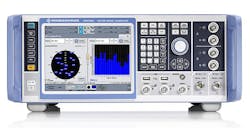Signal generator for satellite navigation signals test and measurement introduced by Rohde & Schwarz
MUNICH – Rohde & Schwarz in Munich is introducing simulation capabilities for the L5/E5 frequency band to the company's R&S SMW200A general purpose vector signal generator that can function as a Global Navigation Satellite System, (GNSS) signals simulator, and can simulate complex interference environments internally in parallel with GNSS signals.
This enhancement adds GPS L5 and Galileo E5 simulation capabilities to the simulator.
The R&S SMW200A GNSS simulator is for test and characterization of multi-constellation and multi-frequency GNSS receivers. With its recently added simulation capabilities for GPS L5 and Galileo E5, the R&S SMW200A can generate complex and realistic test scenarios with as many as 144 channels in the GNSS frequency bands L1, L2 and L5.
In addition to GPS (L1/L2/L5), GLONASS (L1/L2), Galileo (E1/E5) and BeiDou (L1/L2), the R&S SMW200A also supports satellite navigation signal generation for QZSS and SBAS on L1. The available channels can be routed to up to four RF outputs, so that even multi-antenna systems can be tested.
The R&S SMW200A also can generate complex coexistence and interference scenarios with multiple interferers. GNSS signals, noise and all interference signals are generated directly in the instrument.
Additional signal sources for external generation of interference signals are not required, resulting in small, compact and simple test and measurement setups.
Today, an increasing number of GNSS receivers are capable of receiving signals on multiple different frequencies, such as L1, L2 and L5. Although this multi-frequency capability, as well as having to process signals from diverse navigation systems such as GPS, GLONASS, Galileo or BeiDou, make the receiver design more complex, they ensure a better quality of service for the end user.
Multi-frequency and multi-constellation processing not only improves positioning accuracy, service availability and robustness, it also makes the positioning process less vulnerable to interference, jamming or spoofing attacks.
For more information contact Rohde & Schwarz online at www.rohde-schwarz.com.
Ready to make a purchase? Search the Military & Aerospace Electronics Buyer's Guide for companies, new products, press releases, and videos
